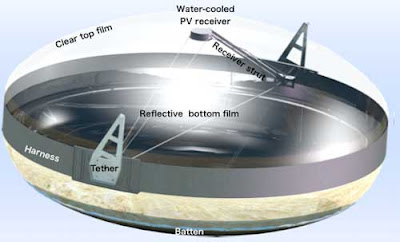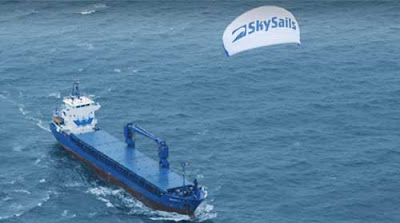The October issue of Discover is spectacular. The focus is on how solar, ethanol, wind and fusion can really work to solve our energy problems.
The first idea is windmills in the sky. Stanford researchers have calculated that 72 billion watts of electricity could be generated 80 meters above the ground; compare this to the 1 trillion watts generated from all sources in the U.S. in 2007.
And if the turbines were higher up (say, a mile-plus), even more could be generated per turbine -- hence the idea of one Australian engineering professor, Bryan Roberts. Roberts and his U.S.-based development company, Sky WindPower, are designing kites that fly up like helicopters to 5000+ feet, then switch over to generating mode. They send power back down through their tethers. The kites are called flying electric generators (FEGs).
Other engineers are working on smaller, cheap, low-altitude kites, such as the ones in development at Worcester Polytechnic Institute in Massachusetts. These would be ideal for going "off the grid" for use in rural or less developed areas.
The update on ethanol focuses on biomass and cellusosic sources, getting away from the current system of using edible food to make fuel. One major problem to solve is gasification of the source materials, in order to make "syngas," which then needs to be converted to ethanol. A company named Coskata is using bacteria to ferment syngas into ethanol, which results in more usable fuel per ton of source material than other methods (100 gallons per ton vs. 70 or 80).
Supplying processing plants with enough material to gasify is another part of the puzzle. The ultimate solution would be to use trash, but getting usable, relatively uniform trash is a big challenge. (The local Linden Hills Power & Light pilot in Minneapolis is giving source separation a try, as one example of how to do it.)
But even if we can separate our trash into useful segments, there may not be enough of it to feed a fully operational ethanol system. Farming waste (the cornstalks instead of the corn) and timber waste (all the smaller branches and leaves that aren't useful to loggers) are two possibilities. It seems clear, at least to me, that there's more established infrastructure for collecting corn waste.
My personal wish is that we could harvest all of the invasive plants that are ruining our countryside. Kudzu, Japanese knotweed and their behavioral cousins produce incredible amounts of biomass each year. Figuring out a way to harvest and transport these weeds with minimal cost and environmental damage, however, is a definite challenge.
If you're wondering about what Discover had to say about breakthroughs in solar power, you won't be disappointed. There's a short but super-inspiring interview with a guy named Rob Lamkin, CEO of Cool Earth Solar, a company founded to find a practical way create a clean energy system that doesn't require any major technical innovations and could be built in a few years.
The system uses plastic balloons, in which half of each sphere is transparent and the other half is reflective. The metallic bowl focuses the sun's rays -- so only a small amount of photovoltaic material is needed (and since it's is expensive, so that's a good thing). According to Lamkin, "The bottom line is that today we can generate electricity as cheaply as, or more cheaply than, we do natural gas -- and we expect to pass coal soon." Wow.
One final story (not from the energy section) fits in here because it's mostly about saving energy. Called "Thinking Outside the Container," it describes three solutions for different inefficiencies and problems related to large-scale shipping, which is generally done using ships that carry those big metal boxes that fit onto train cars or semi tractor trailers.
First is the SkySail -- literally a big, kite-like sail that cuts the amount of fuel needed to power the ships by up to 50 percent. Made in Germany, the sails can be added to the existing fleet. Second is engineer Michael Parsons' system for managing the water used as ballast -- instead of taking water in at the beginning of the trip and dumping it (and its accompanying exotic flora and fauna) out at the end, Parsons has created a way to exchange the water continuously as the ship is in transit, so that it is never far from its origin. Third is GE's hybrid tugboat. Since tugs spend more than three-quarters of their time idling, converting them to hybrids would save a large amount of the fuel they currently use, as well as cutting emissions.
Discover is always a welcome read at my house, but this issue was especially inspiring.
Monday, September 8, 2008
Discover Fuels the Future
Posted at
7:29 PM
![]()
![]()
Categories: Good Technology, Part of the Solution
Subscribe to:
Post Comments (Atom)


No comments:
Post a Comment